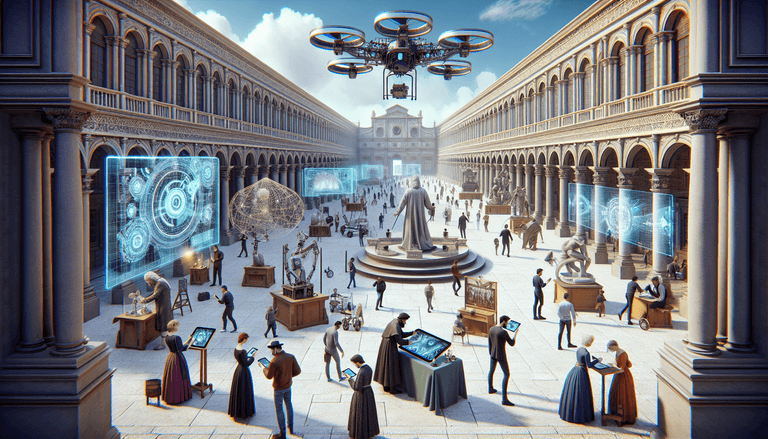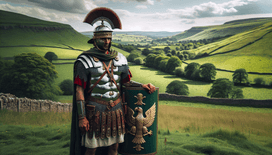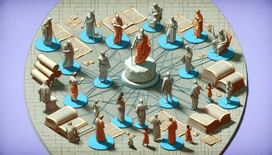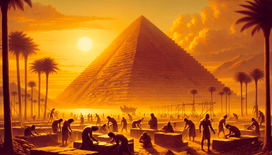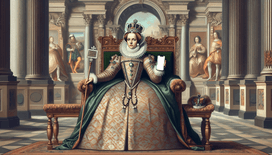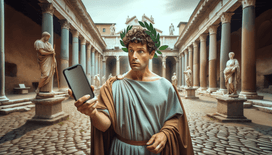Ah, the Renaissance, a time of rebirth, humanism, and art that occasionally included suspiciously chubby babies with wings. Imagine if this period of cultural blooming had been given a hyper-speed upgrade, courtesy of the internet. Buckle up, dear readers, as we journey through time and warp the Renaissance into a Wi-Fi wonderland.
Renaissance Re-invented
Picture this: It’s 15th century Florence, but instead of the pages of dusty tomes clashing in candlelit rooms, there’s a new buzzword in town, low and behold, "Wi-Fi", and it's taking the world by storm. Who needs vellum when you can blog? Why bother foraging for deep pockets of humanism when you can just Google how to be deep?
The "iPaint" Revolution
Oh, how Leonardo da Vinci would rejoice in the electric glow of a screen, sketching on his brand new tablet with a stylus designed by yours truly, Smart da Vinci™. The Mona Lisa would likely have had a vastly different outcome, her enigmatic smile might have been swapped for a ranged selection of emojis, affectionately known as the"Mona LOL-sa." Da Vinci would list the painting on eBay, with an auction starting bid of 100,000 Florins. Meanwhile, his "Last Supper" would morph into a viral food blog post, "How to Cater for 13 with Minimalist Chic" might well be a major hit.
The Bard Blogs
What of William Shakespeare, you say? Our favourite quill-wielding wordsmith would face a new challenge, not the plague, but internet trolls on every hashtag imaginable. To tweet, or not to tweet, that is the very valid question. With a blog aptly titled "To Blog or Not to Blog," Shakespeare’s content calendar would be packed. His lesser-known plays would regain their recognition thanks to clickbait headlines like, "10 Things I Hate About Titus Andronicus."
The Pasta-netti Effect
Michelangelo might have swapped chisels for Photoshop, creating endless memes of David sporting trendy beards and ironic glasses. "Teens react to the Sistine Ceiling Challenge" also becomes a YouTube fundraising campaign. As for the culinary Renaissance, Italians across the peninsula posting photos of their madre’s classic pasta dishes on "InstaGnocchi" would mandate a pasta-in-fluencer boom; after all, why find new continents when you can find new pasta shapes?
Dante’s Downloads
Dante Alighieri’s timeless journey through hell would be available on Kindle with the latest updated version, "Dante’s Digital Downloads," featuring instant footnotes and angelic recommendations. The Inferno could be live-streamed with on-the-ground Twitter reactions noting, "Abandon all hope, ye who scroll here." Lot more drama and far fewer penalty fines for oversized manuscripts smuggled along the Seine.
Networking the Intelligentsia
The intellectual salons would come alive, not with perfume but with Twitter storms. Galileo urging followers to "shift their paradigm," whilst shooing away fake news about earth flat-earthers, would utterly transform our appreciation towards science and astronomy. Email newsletters, "The Everyman’s Enlightenment," would be spearheaded by Copernicus as he shares his new puzzle piece theory of heliocentrism with optimistic "watch my TED Talk" undertones.
Closing Time-Servers
As we saunter back through the ages and shake off this cheeky musing over Wi-Fied visions, one thing is clear: the Renaissance was exceedingly marvellous in its original analog form. While the addition of the internet might be a pandora pride of productivity, we can't help wonder whether it would have forced some of history’s brightest stars into content-producing machines, sapping creative power with virality fatigue. Yet, perhaps this burst of intermediary imagination serves us better reflective than participatory, inviting us to cherish the quietude of these historic minds that beckon quietly from behind oaken table tops, unfinished frescoes, and handwritten notes.
